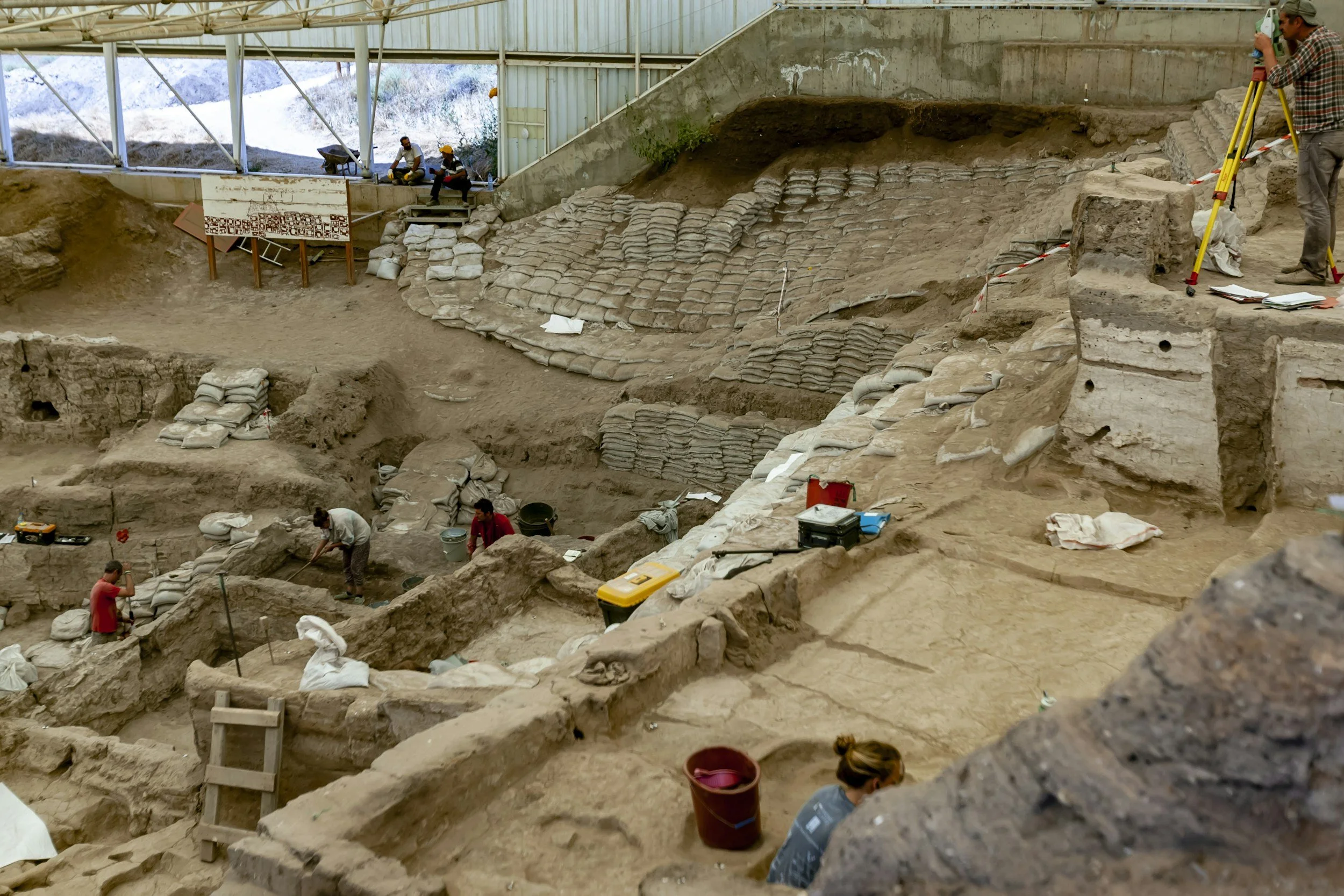Once Again, The Bible Is Proven Correct: 3,000 Year Old Shrine Discovery Sheds New Light on Biblical History and Its Significance for Modern Christianity
I preach to my church regularly that true science always validates Scripture, and vice versa. What Scripture teaches about history is often mocked before new discoveries prove it’s validity. And it happens all the time!
For a long time, skeptics argued that the Hittites, mentioned all throughout the Old Testament, were just a made-up people group. There was no historical or archaeological evidence of their existence, and critics would say, “See, the Bible’s inventing nations!” But then, in the late 19th century, archaeologists unearthed an entire Hittite civilization in what is now Turkey. They even found Hittite records that confirmed interactions with other well-known nations like Egypt. Boom—case closed.
You know the story of Jericho, right? The one where Joshua and the Israelites march around the city, and the walls come tumbling down? Some archaeologists claimed Jericho either didn’t exist at that time or wasn’t a walled city. But more modern digs have revealed evidence of massive walls and even signs of destruction that line up with the biblical timeline. Some findings even suggest that the walls fell outward, which is super unusual for a city under siege—unless, of course, God was involved.
For years, people doubted whether Pontius Pilate, the Roman governor who sentenced Jesus to death, was a real historical figure. He wasn’t mentioned in many Roman records, and critics said he was just a fictional character created by early Christians. Then, in 1961, an inscription was discovered in Caesarea Maritima with Pilate’s name and title engraved on it. It literally says, "Pontius Pilate, Prefect of Judea." Can you imagine the skeptics’ faces when that came to light?
Some archaeologists and historians once thought King David was more of a mythological figure, like King Arthur, rather than a real historical king. That is, until the Tel Dan Stele was discovered in the 1990s. It’s an ancient stone inscription that references the “House of David” and a king of Israel. That find was huge because it confirmed David’s existence and his significant role in history.
This one’s fascinating! People used to say the story of Sodom and Gomorrah was just symbolic, not historical. But archaeological discoveries near the Dead Sea have revealed ancient cities like Tall el-Hammam that show signs of sudden, intense destruction—possibly by fire and brimstone. Some scientists even speculate that a meteor explosion over the region could have caused the devastation, which lines up eerily with the Bible’s account.
Isn’t it wild how things like this keep coming up? It’s like God left a trail of breadcrumbs in history, and every time someone doubts, something surfaces to say, “Actually, the Bible got it right.” So this story might not be much of a ‘proving-doubters-wrong’ case, but it still only validates the Bible’s accuracy.
In a groundbreaking archaeological discovery near Jerusalem’s Temple Mount, researchers have uncovered a 3,000-year-old shrine believed to date back to the 8th century BC. This find provides a tangible connection to the biblical account of King Hezekiah’s religious reforms, as recorded in the books of 2 Kings and 2 Chronicles. The discovery offers a rare glimpse into the ancient practices of worship and the pivotal shifts in religious life during one of Judah’s most transformative eras. I want to delve into the details of the discovery, its historical and theological implications, and its relevance to modern Christianity and the everyday Christian.
To remind us of the Bible’s narrative of Hezekiah and his actions as king, let’s look again at what the Bible says:
2 Kings 18:3–6 (ESV)
Hezekiah is described as doing "what was right in the eyes of the Lord," following David’s example. He removed the high places, broke down sacred pillars, cut down the Asherah poles, and even destroyed the bronze serpent Moses had made because the people had begun to worship it.
2 Chronicles 29–31 (ESV)
Chapter 29: Hezekiah reopens and cleanses the Temple, calling the priests and Levites to purify themselves and restore proper worship. He leads the people in a renewed Passover celebration.
Chapter 30: Hezekiah invites all of Judah and even Israelites from the northern kingdom to celebrate the Passover in Jerusalem, emphasizing unity in worship of the Lord.
Chapter 31: He implements further reforms by organizing the priests and Levites, ensuring their proper provisions, and systematically removing remnants of idolatry throughout the land.
King Hezekiah, one of Judah’s most faithful kings, led a significant spiritual revival. He began by purging the land of idolatry, dismantling pagan altars, high places, and objects associated with false worship. He restored the Temple in Jerusalem, reinstituted proper worship practices, and reestablished the Passover, inviting both Judah and remnants of Israel to partake. Hezekiah's reforms not only revitalized religious observance but also emphasized returning to God's covenant and abandoning syncretism. His leadership profoundly impacted the spiritual life of Judah, aligning the nation more closely with God’s commands. And his existence and work has now been independently verified.
Who, What, When, Where, & Why (and How)Bottom of Form
Who Discovered It?
The excavation was conducted by the Israel Antiquities Authority (IAA), led by archaeologist Eli Shukron. Shukron and his team are known for their extensive work in uncovering sites of biblical significance around Jerusalem.
What Was Discovered?
The site consists of an eight-room shrine containing:
A sacred standing stone (matzevah), often associated with pagan worship.
An altar, likely used for offerings.
Olive oil and wine presses, indicating ritualistic practices.
Artifacts including cooking pots, jars with Hebrew inscriptions, loom weights, scarabs, stamps, and grinding stones. These items suggest the site functioned as both a place of worship and a center for community life.
When Was It Built and Sealed?
The shrine dates back to the 8th century BC, aligning with the reign of King Hezekiah (circa 715–686 BC). The site was deliberately sealed off with a stone wall, a practice consistent with Hezekiah’s reforms to centralize worship in Jerusalem and eliminate unauthorized religious sites.
Where Is It Located?
The shrine was discovered near Jerusalem’s Temple Mount, a location of immense historical and religious significance.
Why Was It Sealed?
According to the Bible, King Hezekiah instituted reforms to consolidate worship at the Temple in Jerusalem and eradicate pagan practices. This deliberate sealing of the shrine aligns with his efforts to centralize worship and restore devotion to Yahweh.
How Was It Uncovered?
The shrine was unearthed during systematic excavations near Jerusalem’s Temple Mount. The intact preservation of the site, due to its intentional sealing, has provided archaeologists with an unprecedented opportunity to study its original context.
Connection to Hezekiah’s Reforms
The Bible recounts Hezekiah’s sweeping reforms in 2 Kings 18:3-6: “He removed the high places, smashed the sacred stones and cut down the Asherah poles. He broke into pieces the bronze snake Moses had made.” This discovery aligns with the historical record, providing material evidence of these reforms. By dismantling decentralized worship sites, Hezekiah sought to unify the nation under Yahweh’s worship at the Jerusalem Temple.
The presence of a standing stone and altar indicates that the shrine was used for rituals incompatible with Hezekiah’s centralized worship mandate. Artifacts like jars with Hebrew inscriptions highlight the blend of cultural and religious practices in ancient Judah, offering insights into the daily lives and spiritual beliefs of its people.
The deliberate closure of the shrine, with its artifacts left intact, mirrors the biblical narrative of Hezekiah’s efforts to eradicate idolatry. This lends credibility to the historical accuracy of the Bible’s accounts of this period.
Why This Discovery Matters
Isn’t it incredible when archaeology and Scripture intersect? This discovery near the Temple Mount gives us more than just ancient artifacts—it offers a window into the world of 8th-century Judah. It’s not just about the stones and shrines; it’s about understanding the socio-religious dynamics of a pivotal era in biblical history. Hezekiah’s reign wasn’t just a time of political upheaval; it was a period of spiritual reformation that shaped the identity of God’s people.
For years, historians and skeptics have debated whether the Bible’s accounts of events like Hezekiah’s reforms were exaggerated or even fabricated. But this discovery ties the textual accounts to physical evidence, reinforcing the historical reliability of Scripture. We’re talking about a moment in history when a king led his nation away from cultural compromise and back to God. And now, we have tangible proof that these events weren’t just stories—they happened in the context of real people, real places, and real decisions.
For Modern Christianity
So, what does this mean for us as modern Christians? Well, first, it reminds us that the Bible isn’t a book of fairy tales or disconnected spiritual lessons. It’s rooted in history. The places mentioned in Scripture, the people who lived there, and the events they experienced—these were real. For anyone who’s ever doubted or been asked, “How do you know the Bible is true?” discoveries like this are a confidence booster. They remind us that our faith is grounded in something solid, not wishful thinking.
This also shows us the timelessness of God’s Word. Hezekiah’s reforms weren’t just about tearing down idols or fixing a broken temple—they were about realigning a nation with God’s heart. And isn’t that what we still need today? This discovery invites us to think about how God has worked in the past and how He’s still working now to call His people back to Him.
For the Everyday Christian
Let’s bring this home—what does all this mean for you and me as we try to live out our faith? Hezekiah’s story is such a wake-up call. Here’s a guy who walked into a culture full of distractions, divided loyalties, and outright idolatry. Sound familiar? Our distractions may not look like golden calves or high places, but let’s be honest—how often do we let work, social media, entertainment, or even good things like family take priority over God?
Hezekiah didn’t just put a Band-Aid on Judah’s spiritual issues; he went straight to the root. He destroyed the idols, removed the high places, and restored true worship. For us, this might mean taking a hard look at our lives and asking, “What’s taking God’s place in my heart?” Maybe it’s a habit that’s become too important, a relationship that’s pulling you away from God, or just the busyness of life crowding out time with Him.
But here’s the thing: Hezekiah didn’t do this alone. He called the priests and Levites to step up, and he rallied the people. In the same way, we don’t have to tackle our spiritual “high places” by ourselves. We’ve got the Holy Spirit to guide us, God’s Word to ground us, and our church communities to encourage us.
So, the next time you read about Hezekiah or hear about an archaeological find like this, let it be a reminder. God has always been in the business of calling His people back to Him, and He’s still doing it today. What “idols” do you need to let go of? What steps can you take to refocus your worship on God alone? Hezekiah’s story isn’t just history—it’s a challenge and an invitation for every believer.



